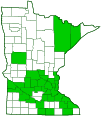Cedar-apple Rust
(Gymnosporangium juniperi-virginianae)
Conservation • Description • Habitat • Ecology • Distribution • Taxonomy
|
|
|||||||||||||
Description |
Cedar-apple Rust infects apple trees and junipers. In the Rose family it infects prairie crabapple and paradise apple, rarely hawthorn. In the Cypress family in infects chiefly eastern redcedar but occasionally also creeping juniper and common juniper. These are the only species affected in Minnesota. Other apple (Malus) and juniper (Juniperus) species are affected in other areas. On apple and crabapple trees, infections begin in the early spring. Bright yellow to orange spots (lesions), often with a red border, appear on the leaves in April and May. As the fungus matures, raised black spots form in the center of the spot on the upper leaf surface, and brownish threads or finger-like tubes, less than 1 ⁄10″ long, form on the lower surface. Eventually, the tubes open to release yellow to orange spores. Rarely, the fungus infects fruit, forming large green to brown spots with black dots on the fruit surface. On eastern redcedar, infections first appear in July and August. Abnormal, greenish-brown growths (galls) appear at the base of a needle or in a crack or crevice of a twig or small branch. As it matures it becomes pitted, more or less circular, and 1″ or more in diameter. The following year, a short, pimple-like bump appears in each depression. The gall overwinters a second time in this form. In the second spring, eighteen months after infection, the bumps elongate, forming finger-like projections. During the first warm rain, sporulation occurs. The projections become bright orange, gelatinous, and ½″ to ¾″ long. This stage lasts for only about two days but may occur several times. The projections dry up, shrink, and become dark brown. The gall will remain on the tree for several years but will not produce more spores. |
Similar Species |
Habitat and Hosts |
Anywhere eastern redcedar grows in close proximity to apples or crabapples, especially near apple orchards. Evergreen hosts: chiefly eastern redcedar; occasionally also creeping juniper and common juniper. Deciduous hosts: prairie crabapple and paradise apple; rarely hawthorn |
Ecology |
Season |
April and May |
Distribution |
||
|
Sources |
|
| 5/29/2024 | ||
Occurrence |
||
Common |
||
Taxonomy |
|
Kingdom |
Fungi (Fungi) |
Subkingdom |
Dikarya |
Phylum |
Basidiomycota (Basidiomycete Fungi) |
Subphylum |
Pucciniomycotina |
Class |
Pucciniomycetes |
Order |
Pucciniales (rust fungi) |
Suborder |
Uredinineae |
Family |
Gymnosporangiaceae |
Genus |
Gymnosporangium |
Until very recently, the genus Gymnosporangium was placed in the family Pucciniaceae. Studies showed that the genus did not belong to Pucciniaceae orto any other existing rust family. In an article published 12/31/2020, it was proposed that a new family Gymnosporangiaceae be created to accommodate the genus. At that time the order Pucciniales (rust fungi) did not have any suborders. In an article published on 7/2/2021 a framework of seven suborders was proposed containing 80% of all rust species. |
|
Subordinate Taxa |
|
|
|
Synonyms |
|
Gymnosporangium macropus Gymnosporangium virginianum Podisoma juniperi-virginianae |
|
Common Names |
|
Cedar-apple Rust Juniper-apple Rust |
|
Glossary
Gall
An abnormal growth on a plant produced in response to an insect larva, mite, bacteria, or fungus.
Sporulation
The process of forming spores.
Visitor Photos |
||
Share your photo of this fungus. |
||
This button not working for you? |
||
Paul |
||
 |
|
|
Randy |
||
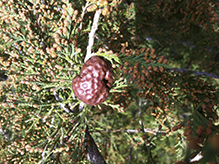 |
|
|
Cedar-apple rust gall on eastern red cedar, Freeborn County, MN, 2016 |
|
|
MinnesotaSeasons.com Photos |
||
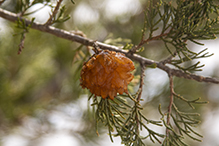 |
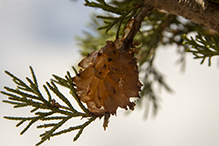 |
|
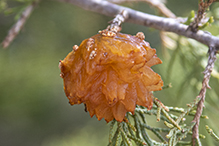 |
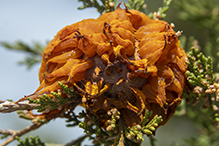 |
|
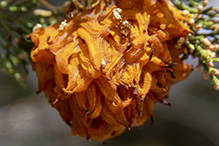 |

Slideshows |
|

Visitor Videos |
||
Share your video of this fungus. |
||
This button not working for you? |
||
|
Other Videos |
||
CedarAppleRust |
About
Published on Sep 7, 2015 University of Minnesota |
Cedar-Apple Rust (Juniper Rusts) |
About
Published on Apr 30, 2015 The cedar rust diseases (Juniper spp.) stand out due to their conspicuous nature, and the fact the fungi that cause them complete their life cycles on two plant hosts — the juniper (cedar) and the apple (although pear, hawthorn, quince, serviceberry, and crabapple are other hosts). All potential host plants are commonly planted in the urban landscape, or are native to the Midwest. In Indiana, there are three common juniper rust diseases, Cedar-Apple Rust, Cedar-Hawthorn Rust, and Cedar-Quince Rust. Regardless of the disease, these rust fungi have similar life cycles and cause similar symptoms in their hosts. In the spring, orange gelatinous horns develop from gray to brown colored fungal galls on the branches of infected junipers. These horns produce wind-blown spores that can infect apple and crabapple trees. For more information, including management, please refer to our publication, “Cedar Apple and Related Rusts on Landscape Plants,” at: https://www.extension.purdue.edu/extm... |
Cedar Apple Rust |
About
Published on Apr 17, 2016 Nebraska Extension Plant Pathologist Loren Giesler shows the orange gelatinous galls of cedar apple rust and talks about how to control them on both cedar and apple trees. |
Cedar-apple Rust |
About
Published on May 1, 2009 Orange masses seen in cedar trees during rainy spells are caused by cedar apple rust. Learn about this complex tree disease here. |
Cedar Apple Rust - Common Plant Diseases in the Landscape and Garden |
About
Published on May 4, 2017 Join Virginia Tech Plant Pathologist, Mary Ann Hansen, as she discusses common plant diseases in Virginia. In this video she talks about Cedar-Apple Rust. Cedar-Apple Rust, like most other rust fungi, needs two hosts to complete it's life cycle. The first of which is spent on the Red Cedar where very distinctive (and creepy) galls form on the tree. For more information on the Virginia Tech Plant Disease Clinic: https://www.ppws.vt.edu/extension/plant-disease-clinic.html For more information on the Virginia Cooperative Extension Master Gardener Program: https://ext.vt.edu/lawn-garden/master-gardener.html |

Visitor Sightings |
||
Report a sighting of this fungus. |
||
This button not working for you? |
||
Paul |
Location: St. Cloud, MN |
| Randy 2016 |
Location: Freeborn County, MN Cedar-apple rust gall on eastern red cedar |
MinnesotaSeasons.com Sightings |
||
|

Created: 12/15/2017 Last Updated: © MinnesotaSeasons.com. All rights reserved. |
